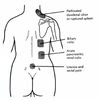Advanced Abdominal Exam COPY Flashcards
(76 cards)
Peritonitis
Inflammation of the peritoneum that results in intense abdominal pain and a board-like abdomen to palpation.
Rebound tenderness
Peritoneal inflammation causes increased pain when the examiner takes away his/her hand abruptly from the abdomen compared to the initial pressing down on the abdomen
Percussion tenderness of the liver, spleen or kidney
Gentle fist percussion using the heel of the hand on the ribs over the liver, spleen or kidney may elicit pain generally caused by stretching or inflammation of the capsule surrounding the organ
Traube’s Space
Traube’s space is defined superiorly by the left 6th rib, inferiorly by the left costal margin, and laterally by the left anterior axillary line.
If dullness is noted upon percussion of Traube’s space, this finding is suggestive of splenomegaly and should be confirmed with palpation for an enlarged spleen.
Hypoactive bowel sound
May be normal or suggest an ileus (obstruction of the intestine due to paralysis of the intestinal muscles.)
Hyperactive bowel sounds
May be normal or suggest an inflammatory or infectious process in the intestines.
High pitched, tinkling bowel sounds
Suggestive of small bowel obstruction
Tympany of the abdomen
Indicates that there is gas in loops of bowel or in the peritoneal space itself.
Shifting dullness on percussion of the abdomen (especially supine vs lateral decubitus)
Suggests fluid in the abdomen (ascites).
Rigidity on palpation of the abdomen
Points toward peritoneal inflammation due to a perforation or rupture of an intraabdominal organ such as stomach, gallbladder, small bowel or colon.
If contraction of the rectus abdominus on palpation is voluntary, it is ____. If it is involuntary, it is ____.
If contraction of the rectus abdominus on palpation is voluntary, it is guarding. If it is involuntary, it is rigidity.
Midline abdominal bruit
Suggests abdominal aortic narrowing or stenosis
Suprapubic abdominal bruit
Suggests iliac artery narrowing or stenosis
Lateral umbilical bruit
Suggests renal artery narrowing or stenosis
Costovertebral angle tenderness
If tenderness is elicited with palpation in the costovertebral angle, it can indicate inflammation in the kidney (pyelonephritis)

Umbilical hernia
A protrusion through a defective umbilical ring is most common in infants but also occurs in adults. In infants, it usually closes spontaneously within 1–2 yrs
May be seen more clearly while the patient is standing.
Inguinal hernia
Presence is noted best in the male patient standing up. The examiner’s finger invaginates the most dependent part of the scrotum to insert the finger in the canal laterally and cephalad.
Ask the patient to cough or strain. A small hernia causes an impulse felt on the fingertip. A larger hernia feels as if there is a mass in the canal.
Caput Medusa
Sign of portal hypertension. Indicates chronic portal vein obstruction. It is a dilatation of the paraumbilical vein that gives the appearance of a rosette around the umbilicus.
When inferior epigastric veins are visible over the abdomen, ___ should be suspected.
When inferior epigastric veins are visible over the abdomen, IVC obstruction should be suspected.
McBurney’s Point
Lies one-third of the distance between the between the anterior superior iliac spine and the umbilicus and is located over where the appendix comes off the base of the cecum.
The pain of acute appendicitis is commonly located at McBurney’s Point.
Rovsing’s Sign
When pressing in on the left lower quadrant elicits pain in the right lower quadrant.
This is an indication of a possible appendicitis.
Rectal tenderness
May indicate a thrombosed hemorrhoid, anal fissure, inflammatory bowel disease, infectious colitis, appendicitis, ischemic colitis, ulcerated rectal cancer or inflamed prostate.
Psoas sign
It is performed by having the patient lie on his/her left side and extending the right leg at the hip to stretch the psoas muscle. If significant pain results, this is a positive psoas sign.
May support the diagnosis of appendicitis, or irritation of any inflamed organ proximal to the psoas.

Obturator sign
It is performed by flexing the patient’s right thigh at the hip with the knee bent and then rotating the leg internally which stretches the obturator muscle. If significant pain results, this is a positive obturator sign.
May support the diagnosis of appendicitis, or inflammation of any pelvic sturcture.
















